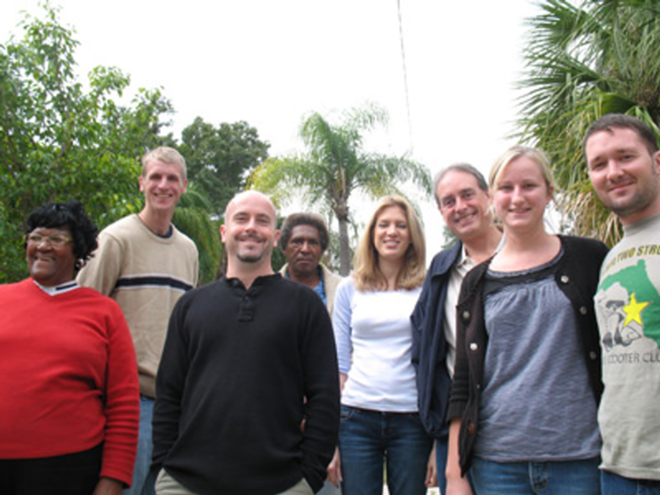
On a bright Saturday morning, eight residents of St. Petersburg's Bartlett Park neighborhood gather in the renovated home of Julie Richey and Stewart Nicol. The former vice president of the neighborhood association, Scott Swift, is here. So are Lindsay Myers, editor of the Bartlett Park Newsletter, and John and Rosemary Kitchen, both elected officers in the association. The Kitchens are black, and longtime residents; the others are white or Hispanic (including one Cuban and one Argentinean couple), and moved to Bartlett Park in the last three years.
Over crumbly coffeecake, the group shares the successes, failures and frustrations of local activism. But then they get down to business: They are meeting today to plot a defection.
For the last year, these residents have labored to improve Bartlett Park. They helped to form a Crime Watch group, started a newsletter, sponsored litter clean-ups and enforced codes regulations in this oft-forgotten part of St. Pete just south of downtown.
But trying to improve the neighborhood, as Brian Wyllie puts it, is "like pushing a lead ball."
Wyllie and the others say the more they work toward making Bartlett Park a safer, cleaner, more hospitable place to live, the harder some in the association push back.
"To those of us that are new, [revitalizing the neighborhood] is still a very slow process," Swift says. "We do a project every three to four months. Everyone else in the city does one every two weeks."
So this group of eight — and two other relatively new residents who couldn't make the meeting — have formed their own organization: the Buena Vista Neighborhood Association, which will focus on the area between Fourth and Martin Luther King streets and 14th and 18th avenues, approximately half of Bartlett Park.
"We're going to continue to do positive things for the neighborhood," Swift says. "But the association has served as an obstacle."
As we enter 2008, I'm reminded of the oft-used maxim: the more things change, the more they stay the same. Bartlett Park's fissures, which I first wrote about last spring ("Here Comes the Neighborhood," April 18, 2007), aren't the only example. The frenzy over drug paraphernalia that overtook Pinellas County in 2006 has spread statewide. And the St. Petersburg City Council is still pondering largely meaningless ordinances directed at the city's homeless.
Here's our first set of updates from stories I wrote about in 2006 and 2007; stay tuned next week for a second installment.
The Bartlett split
Change has never come easily to Bartlett Park. In the 1970s, white flight turned the 30-block neighborhood into a predominantly African-American district. When the crack epidemic hit St. Pete in the '80s, Bartlett Park regressed to a crime haven, sheltering the most powerful drug dealer in Tampa Bay. Throughout the '90s, the neighborhood was synonymous with poverty.
Then, during the latest housing boom, investors and homeowners eyed the area, buying up the cheap housing stock and filling vacant lots with new homes. But progress created another kind of discord.
As the neighborhood inched toward revitalization, some longtime black residents worried aloud that the influx of mostly white newcomers was pushing them out. They complained change was happening too fast. New residents and investors disagreed and wondered why anyone would question their improvement efforts.
After the April Creative Loafing story, several residents said relations between neighbors warmed, leading to the launch of several projects: the first Crime Watch group in 15 years, a newsletter and numerous block parties and beautification projects.
But tension remained.
Newcomers complained changes were coming too slow. Myers, the Bartlett Park newsletter editor who moved to the neighborhood in April, says there were disagreements over putting the city's codes enforcement phone number in the newsletter. Other efforts, like holding crime watch meetings in new residents' backyards, were also criticized, she says.
But worse, newcomers say, some longtime association members viewed their neighborhood activism suspiciously. And this suspicion manifested itself in racial terms. "White takeover" has been a phrase heard often.
"I feel vilified just for living here," Myers says.
And during neighborhood association meetings, newer members felt excluded from decision-making, says Swift.
"[Some members of the association] oppose the credibility of anybody new," he says. "You can't say, 'I've been here 30 years and you've been here one year and your opinion doesn't matter.'"
Discord came to a head at the December association meeting when elections were held, and fierce arguments arose over who was allowed to vote. In the end, Swift resigned from his post as vice president and walked out.
"It makes people uncomfortable to see all this hostility," says Tom Tito, the association's president, who is white. "A lot of black residents have stopped coming [to the association meetings]. They don't want to disagree, so they just don't come."
That, in turn, creates an association in a predominantly black neighborhood led largely by white new residents. Tito says this can give the rest of the neighborhood a bad perception of the work the association does.

